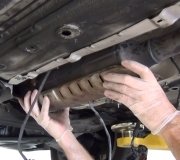What you don't want to see is what you described in the first paragraph. The upstream sensor should be switching rapidly if you rev up the engine, if the converter is working properly the downstream sensor should change to a close to steady voltage as the converter heats up and starts to burn off the exhaust gasses. In the image attached the left side images are the upstream and the right side are the downstream sensors. The upper set are a good converter while the lower set show a bad unit.
For the code you have, When the car is first started from a cold start the PCM starts a timer and it looks at the signals from the O2 sensors and if the downstream sensor doesn't start to smooth out fast enough (to indicate the converter is heating up and working) it sets the code you have. However because you are not getting the P0420 code the converter is working, it's just not working fast enough on the initial cold start. That is why you don't have the symptoms of a bad converter as well.
As for which unit to use, that is why I suggest talking to a local shop, Your car is a California emissions vehicle, using anything but a California approved replacement may not be legal. It also could cause you to have the same code you currently have because of the way the PCM monitors the emissions system your car has. Plus the unit you would be replacing isn't the one under the car, it is the one that is part of the exhaust manifold as shown in the second image. The upstream O2 sensor is in that unit while the downstream sensor is in the pipe in front of the second converter that is in the pipe under the car. The third image shows the under car pipe with the downstream O2 sensor location circled. That second converter isn't monitored at all. However you will want to check over the entire system for leaks, before replacement, it is possible that a leak at the front flange gasket where the front pipe connects to the center pipe could in theory set the code if it was able to leak until it got hot and sealed up. Would probably be worth it to swap out that gasket (circled wit G) with new one before you spend the money on the front converter. Replacing the rear converter in that pipe shouldn't be needed unless the car were to fail a tailpipe sniffer test with the front unit working.
Images (Click to make bigger)
Saturday, August 1st, 2020 AT 5:44 AM
















